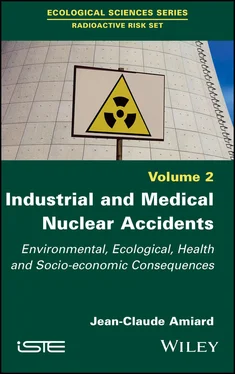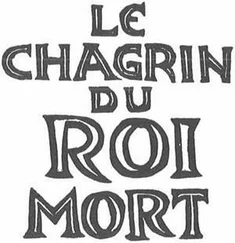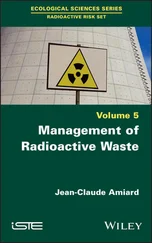In addition, some cells are more radiosensitive than others. This is true for both plant and animal species, in addition to sensitivity differences between individuals. In a single species, in most cases, the first stages of life (embryo, fetus, child) are much more radiosensitive than adults and old people [AMI 16].
Nuclear accidents are covered in a series of three volumes. The first volume is dedicated to definitions and classifications of nuclear accidents of military origin. It then tackles the consequences of the actions taken in warfare at Hiroshima and Nagasaki, then atmospheric testing of nuclear bombs and accidents that occurred during underground testing. The use of military force to act as a nuclear deterrent has caused various accidents, in particular among submarines and bomber aircraft. This first volume also considers the various accidents that have occurred during the manufacture of nuclear weapons, in particular those of criticality. This book finishes with estimations of the effects of a possible nuclear war.
This book, the second volume in the series, is dedicated to accidents related to civilian use of nuclear technology, from the points of view of civil engineering, the production of electricity and tools for human health (in particular, detection and radiotherapy). Electricity production depends on several stages. Yet, accidents can occur at various stages of the fuel cycle, from mining to reprocessing of the exhausted fuel. Specific chapters are devoted to accidents that occurred in the Chernobyl and Fukushima nuclear reactors. A later chapter evokes the possible consequences of acts of terrorism. For each of the first two volumes, the consequences of nuclear accidents are detailed for the terrestrial, freshwater and marine environments and their flora and fauna, human health, as well as sociological, psychological and economic consequences.
The third volume will expand on the future management of nuclear accidents, in particular looking at activities involving decontamination, feedback, post-accident management, risk, perception, Industrial Intervention Plans (PPIs in France) and the need to take potential accidents into account during project design.
The book also includes a list of acronyms.
Nuclear accidents and disasters have given rise to an abundant literature. Why produce more books on the subject? Many books are openly pro- or anti-nuclear. The intention of the volumes in this series is to provide the reader with a clear, transparent and objective summary of the relevant scientific literature.
Jean-Claude AMIARD
March 2019
Claude Amiard-Triquet (Honorary Research Director, CNRS, France) has taken on the onerous task of re-reading, annotating and casting a critical eye over the French version of this book, and Professor Philip Rainbow (former Keeper of Zoology, Natural History Museum, London, United Kingdom) has done the same for the English version. I warmly thank them both for their time and efforts.
A certain number of colleagues have made documents available to me and I am grateful for this. They are in particular Christelle Adam-Guillermin from the IRSN, Pierre-Marie Badot at the Université de Besançon, Mariette Gerber from INSERM in Montpellier, Anders Pape Møller from the CNRS at the Université de Paris Sud (Orsay) and Timothy Mousseau at the University of South Carolina and Jean-Claude Zerbib (radiation protection expert). I hope I have not forgotten anyone.
I would also like to thank the members of the GNRC (Nord-Cotentin Radioecology Group), a multi-faceted group, for the remarkable work that they have accomplished, working together in complete harmony.
ACRO:Association pour le Contrôle de la Radioactivité dans l’Ouest (French Association for the Management of Radioactivity in Western France)AF:Accumulation FactorALPS:Advanced Liquid Processing SystemARS:Acute Radiation SyndromeASN:Autorité de Sûreté Nucléaire (French Nuclear Safety Authority)ASTRAL:Assistance technique en radioprotection post-accidentel (French Technical Assistance for Post-accident Radiation Protection)ATSDR:Agency for Toxic Substances and Disease RegistryBMI:Body Mass IndexBNFL:British Nuclear FuelsBOC:Bialystok Oncology CenterCEA:Commissariat à l’Énergie Atomique (French Atomic Energy Commission)CI:Confidence IntervalCLL:Chronic Lymphocytic LeukemiaCNEVA:Centre National d’Études Vétérinaires et Alimentaires (National Center for Veterinary and Food Studies)CR:Concentration RatioCRIIRAD:Commission de Recherche et d’Information Indépendantes sur la RADioactivité (Commission for Independent Research and Information about RADiation)CRN:Commission de Régulation NucléaireCSM:Centre de Stockage des déchets à vie longue et haute activité de la MancheCTCAE:Common Terminology Criteria for Adverse EventsEBRD:European Bank for Reconstruction and DevelopmentEDF:Electricité de France (Electricity of France)EEZ:Exclusive Economic ZoneEHL:Ecological Half-LifeEIS:Événements Intéressants la Sûreté (Events of Interest for Safety)EMEX:Estonian Metal Export CompanyERR.Gy−1:Excess Relative Risk per Gray exposureFA:Fluctuating AsymmetryFEPC:Federation of Japanese ElectriciansFNPP:Fukushima Daiichi Nuclear Power PlantGSH:GlutathioneHPIP:Human Performance Investigation ProcessIAEA:International Atomic Energy AgencyICPR:International Commission on Radiological ProtectionIGAS:General Inspectorate of Social AffairsIICPH:International Institute of Concern for Public HealthINES:International Nuclear Event ScaleINRS:Institut National de Recherche et de Sécurité (French National Institute of Research and Safety)ION:Instituto Oncológico NacionalIPPNW:International Physicians for the Prevention of Nuclear WarIRS:Incident Reporting SystemIRSN:Institut de Radioprotection et de Sûreté (French Institute for Radiation Protection and Safety)ISF:Interim Storage FacilityISS:Incidents Significatifs pour la Sûreté (Safety Significant Incidents)JCO:Japan Nuclear Fuels Conversion CompanyKMPS:Kurion Mobile Processing SystemLCHA:Laboratoire Central d'Hygiène AlimentaireLDIR:Low-Dose Ionizing RadiationLILW:Low- to Intermediate-Level WasteLNT:Linear No ThresholdLWPE:Leningrad Regional Waste Processing EnterpriseMAC:Maximum Allowable ConcentrationMAS:Maximum Acceptable StandardMEL:Laboratoire de l’environnement marin (French Marine Environment Laboratory)MHA:Medium- and High-Level WasteMoE:Ministry of the EnvironmentMT:MetallothioneinNAMS:Nuclear Accident Magnitude ScaleNEA:Nuclear Energy AgencyNHL:Non-Hodgkin’s LymphomaNISA:Nuclear and Industrial Safety AgencyNMRD:Non-Malignant Respiratory DiseaseNPP:Nuclear Power PlantNRC:Nuclear Regulatory CommissionNRU:National Research Universal reactorNSSA:Nuclear Safety and Security AgencyOECD:Organization for Economic Co-operation and DevelopmentOFPP:Office Fédéral de la Protection de la Population (French Federal Office for the Protection of the Population)OR:Odds RatioPTSD:Post-Traumatic Stress DisorderPUNE:Peaceful Underground Nuclear ExplosionRDP:Radon Degradation ProductRER:Relative Excess RiskSCPRI:Service Central de Protection contre les Rayonnements Ionisants (Central Protection Service Against Ionizing Radiation)SdP:Pumping StationsSFRO:Société Française de Radiothérapie Oncologique (French Society of Oncological Radiotherapy)SFRP:Société Française de Radioprotection (French Radioprotection Society)SIR:Standardized Incidence RatioSME:Small and Medium-sized EnterpriseSOL:Safety through Organizational LearningSRE:Sodium Reactor ExperimentSS:Suspended SolidsSSFL:Santa Susana Field LaboratoryTEPCO:Tokyo Electric Power CompanyTF:Transfer FactorTHORP:Thermal Oxide Reprocessing PlantTMI:Three Mile IslandTPS:Treatment Planning SystemTSH:Thyroid-Stimulating HormoneUAM:Unit-Alpha-MonthsUNSCEAR:United Nations Scientific Committee on the Effects of Atomic RadiationWANO:World Association of Nuclear Operators
Читать дальше












